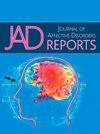Decreased PON1 activity as a biological marker for depressive disorders: a narrative review
Q3 Psychology
引用次数: 0
Abstract
Background
This study conducts a narrative review to summarize evidence regarding changes in serum/plasma paraoxonase 1 (PON1) activity in patients with major depressive disorder (MDD) or other depressive disorders and assess their possible marker value.
Methods
We searched the PubMed database for articles published from inception to December 2024 on the relationship between depression and PON1 activities/concentrations.
Results
Seventeen articles from 2006 to 2022 were included in the final analysis. 70 % of the studies demonstrated a decline in PON1 (predominantly arylesterase activity) during MDD episodes and depressive disorders induced by methamphetamine and Parkinson`s disease. Lower PON1 paraoxonase activity was associated with the number of previous depressive episodes (DE), worse outcomes, and higher DE severity. Two studies showed an increase in PON1 activity after antidepressant treatment. The decline of PON1 has a genetic predisposition. QQ and QR genotypes of PON1 increased the odds of depression. MDD patients with QQ genotype (in contrast to QR and RR) showed lowered PON1 activity.
Conclusion
There is a decline in arylesterase/paraoxonase activity and PON1 concentrations in MDD and secondary depressive disorders. The decline is also associated with the severity and number of DE. Antidepressant treatment might increase PON1 activity. Genetic predisposition and epigenetic mechanisms that decrease PON1 activity might disrupt antioxidative mechanisms and lipid metabolism, which could be a part of complex pathogenesis and/or lead to comorbid somatic MDD pathology related to accelerated aging. PON1 activity and concentrations decline might be a marker for MDD and other DE, whereas PON1 increase – for treatment efficacy.
PON1活性降低作为抑郁症的生物学标志物:一项叙述性综述
本研究对重度抑郁症(MDD)或其他抑郁症患者血清/血浆对氧磷酶1 (PON1)活性变化的证据进行综述,并评估其可能的标志物价值。方法检索PubMed数据库中自成立至2024年12月发表的有关抑郁症与PON1活性/浓度关系的文章。结果2006 - 2022年共纳入17篇文章。70%的研究表明,在甲基苯丙胺和帕金森病引起的重度抑郁症发作和抑郁症期间,PON1(主要是芳基酯酶活性)下降。较低的PON1对氧磷酶活性与既往抑郁发作(DE)次数、较差的结局和较高的DE严重程度相关。两项研究显示抗抑郁治疗后PON1活性增加。PON1的下降有遗传易感性。PON1的QQ和QR基因型增加抑郁的几率。QQ基因型MDD患者(与QR和RR相比)PON1活性降低。结论重度抑郁症和继发性抑郁症患者芳香酯酶/对氧磷酶活性和PON1浓度均有下降。这种下降也与DE的严重程度和次数有关。抗抑郁治疗可能会增加PON1活性。遗传易感性和表观遗传机制降低PON1活性可能会破坏抗氧化机制和脂质代谢,这可能是复杂发病机制的一部分和/或导致与加速衰老相关的躯体MDD共病病理。PON1活性和浓度的下降可能是MDD和其他DE的标志,而PON1的增加可能是治疗效果的标志。
本文章由计算机程序翻译,如有差异,请以英文原文为准。
求助全文
约1分钟内获得全文
求助全文
来源期刊

Journal of Affective Disorders Reports
Psychology-Clinical Psychology
CiteScore
3.80
自引率
0.00%
发文量
137
审稿时长
134 days
 求助内容:
求助内容: 应助结果提醒方式:
应助结果提醒方式:


